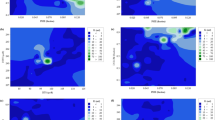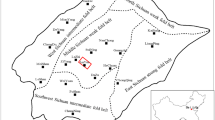Abstract
Multi-frequency dielectric scanning logging is an advanced method that plays a critical role in evaluating unconventional oil and gas reserves and residual oil distribution. This method provides higher accuracy compared to conventional logging and can obtain essential formation parameters such as formation water salinity, pore textural index, and dispersive phase volume fraction. Despite its advantages, the inversion of permittivity and conductivity measurements at multiple frequencies into formation properties remains a "black box" problem. This challenge makes it challenging to understand specific implementation methods and inversion techniques without purchasing expensive software and hardware from oil field service companies. To address this issue, this work proposes a publicly available and advanced intelligent optimization algorithm. Our approach reduces calculation complexity and achieves high accuracy in evaluating petrophysical properties, including shaly sand reservoirs, without relying on costly software services from oil field companies. Our method offers distinct advantages over traditional approaches, such as the ability to derive formation properties from dielectric logging information with confidence, without specialized equipment or software from commercial providers. Additionally, the open-source code is readily available in various programming languages, including Python, R, and Matlab, making our approach accessible and easy to implement.
Similar content being viewed by others
Data Availability
The data that support the findings of this study are available China University of Petroleum (Beijing). Restrictions apply to the availability of these data, which were used under license for the current study and so are not publicly available. However, data are available from the authors upon reasonable request and with permission from China University of Petroleum (Beijing).
Abbreviations
- S w :
-
Water porosity fraction
- S :
-
Formation water salinity
- MN :
-
Pore textural index
- p d :
-
Clay dispersion volume fraction
- ε r :
-
Dielectric constant
- σ :
-
Electrical conductivity
- ϕ :
-
Porosity
- ϕ w :
-
Water-filled porosity
- T :
-
Temperature
- ε ∞ :
-
High-frequency limit dielectric constant
- ε s :
-
Low-frequency limit dielectric constant
- ε 0 :
-
Permittivity of free space
- f c :
-
Critical frequency
- ε * w :
-
Water phase permittivity (complex form)
- σ w :
-
Water phase conductivity
- ε rw :
-
Water phase relative permittivity
- ε h :
-
Hydrocarbon permittivity
- ε m :
-
Matrix permittivity
- ε * :
-
Integrated permittivity
- σ d :
-
Dispersive phase conductivity (shaly sandstone)
- ε * d :
-
Permittivity (shaly sandstone)
- ε rm :
-
Matrix relative permittivity
- ε * c :
-
Integrated conductive phase dielectric constant (shaly sandstone)
- F1 :
-
The first optimization target
- F2 :
-
The second optimization target
- n:
-
Number of the emitted frequencies
- ε rtarget :
-
Target permittivity
- σ rtarget :
-
Target conductivity
- \(\overrightarrow{A}\) and \(\overrightarrow{C}\) :
-
Coefficient vectors in the grey wolf algorithm
- \(\overrightarrow{{r}_{1}}\) and \(\overrightarrow{{r}_{2}}\) :
-
Random vectors in the grey wolf algorithm
- \(\overrightarrow{a}\) :
-
Vector during the iteration process
- \(\overrightarrow{D}\) :
-
Distance vector
- \(\overrightarrow{X}\) :
-
Position vector
- t:
-
Iteration time
References
Aceves, J.M., Manuel Aceves, J., Couper, I.D.: Electrical conductivity in insulating materials. 1982 IEEE Intl. Conf. Electric. Insul. (1982). https://doi.org/10.1109/eic.1982.7464457
Donadille, Faivre, Leech. Fundamentals of Dielectric Dispersion Logging. Schlumberger Digital Marketing, Sugar Land, ISBN 2016.
Wu, T., Berg, R.R.: Relationship of reservoir properties for shaly sandstones based on effective porosity. Petrophysics. 44(5) (2003)
Argaud, M., Giouse, H., Straley, C., Tomanic, J., Winkler, K.: Salinity and Saturation Effects on Shaly Sandstone Conductivity. SPE Annual Technical Conference and Exhibition (1989)https://doi.org/10.2118/spe-19577-ms
Lin, C.M.: Study of Dielectric Constant Logging Tools. Master thesis, University of Houston (2012)
Waxman, M.H., Smits, L.J.M.: Electrical conductivities in oil-bearing shaly sands. Soc. Petrol. Eng. J. (1968)
Seleznev, N.V., Habashy, T.M., Boyd, A.J.: Formation properties derived from a multi-frequency dielectric measurement. SPWLA 47th Annual (2006)
Meador, R.A., Cox, P.T.: Dielectric constant logging, a salinity independent estimation of formation water volume: Trans. Eng of AIME Dallas, Texas(Sept 28-Ott 1) Paper SPE (1975)
Malmberg, M.: Dielectric Constant of Water from 00 to 1000 C. J. Res. Natl. Bur. Stand. A Phys. Chem. 56 (1956)
Misra, S., Han, Y., Jin, Y., Tathed, P.: Multifrequency Electromagnetic Data Interpretation for Subsurface Characterization. Elsevier (2021)
Hizem, B., Deville, F.: Dielectric dispersion: A new wireline petrophysical measurement. SPE Annual Technical Conference and Exhibition (2008)
Ara, T.S.: In-depth investigation of Archie equation in carbonate rocks (2003)
Garcia, H.: Integrated characterization of multi-frequency dielectric dispersion measurements in mixed-wet rocks. SPWLA 59th Annual Logging Symposium (2018)
Zhang, Y.: Study of dielectric tools and dielectric property of rocks (2014)
Koledintseva, M.Y., DuBroff, R.E., Schwartz, R.W.: A maxwell garnett model for dielectric mixtures containing conducting particles at optical frequencies. Prog. Electromag. Res. 63, 223–242 (2006)
Knight, R., Endres, A.: A new concept in modeling the dielectric response of sandstones: Defining a wetted rock and bulk water system. Geophysics 55, 586–594 (1990)
Gkortsas, V.M., Venkataramanan, L., Fellah, K.: Comparison of different dielectric models to calculate water saturation and estimate textural parameters in partially saturated cores (2018)
Zhang, A., Wang, M.: Deep Dielectric-Based Water Saturation in Freshwater and Mixed Salinity Environments. SPWLA 62nd Annual Logging Symposium (2021)
Shahin, A., Myers, M., Hathon, L.: Global optimization to retrieve borehole-derived petrophysical properties of carbonates. Geophysics 85, D75-82 (2020)
Zhao, P., Fu, J., Shi, Y., Li, G., Ostadhassan, M., Luo, M., et al.: Hydrocarbon saturation in shale oil reservoirs by inversion of dielectric dispersion logs. Fuel 266, 116934 (2020)
Mirjalili, S., Mirjalili, S.M., Lewis, A.: Grey Wolf Optimizer. Adv Eng Softw 69:46–61 (2014)
Mirjalili, S., Saremi, S., Mirjalili, S.M., Coelho L dos S.: Multi-objective grey wolf optimizer: A novel algorithm for multi-criterion optimization. Expert. Syst. Appl. 47:106–19 (2016)
Stroud, D., Milton, G.W., De, B.R.: Analytical model for the dielectric response of brine-saturated rocks. Phys Rev B Condens Matter 34, 5145–5153 (1986)
Clavier, C., Coates, G., Dumanoir, J.: Theoretical and Experimental Bases for the Dual-Water Model for Interpretation of Shaly Sands. SPE J 24(02):153–168. SPE-6859-PA (1984)
Han, C., Suarez, D.: Continous estimate of cation exchange capacity from log data: A new approach based on dielectric dispersion analysis. SPWLA 53rd Annual Logging Symposium (2012)
Acknowledgements
This work is supported by the Science Foundation of China University of Petroleum, Beijing (2462021QNXZ004).
Author information
Authors and Affiliations
Corresponding author
Ethics declarations
Conflict of Interests
The authors declare that they have no conflict of interest.
Additional information
Publisher's Note
Springer Nature remains neutral with regard to jurisdictional claims in published maps and institutional affiliations.
Appendix 1
Appendix 1
Rights and permissions
Springer Nature or its licensor (e.g. a society or other partner) holds exclusive rights to this article under a publishing agreement with the author(s) or other rightsholder(s); author self-archiving of the accepted manuscript version of this article is solely governed by the terms of such publishing agreement and applicable law.
About this article
Cite this article
Jia, B., Xian, C., Jia, W. et al. Improved Petrophysical Property Evaluation of Shaly Sand Reservoirs Using Modified Grey Wolf Intelligence Algorithm. Comput Geosci 27, 537–549 (2023). https://doi.org/10.1007/s10596-023-10217-2
Received:
Accepted:
Published:
Issue Date:
DOI: https://doi.org/10.1007/s10596-023-10217-2




